Key takeaways:
- Social media campaigns thrive on adaptability; real-time data can dramatically enhance engagement through small tweaks.
- Identifying and understanding the target audience is essential; effective strategies include analyzing data, conducting surveys, and creating audience personas.
- Choosing the right social platforms based on audience habits and content style increases campaign effectiveness.
- Measuring campaign performance via engagement metrics and setting specific KPIs is crucial for evaluating success and informing future strategies.
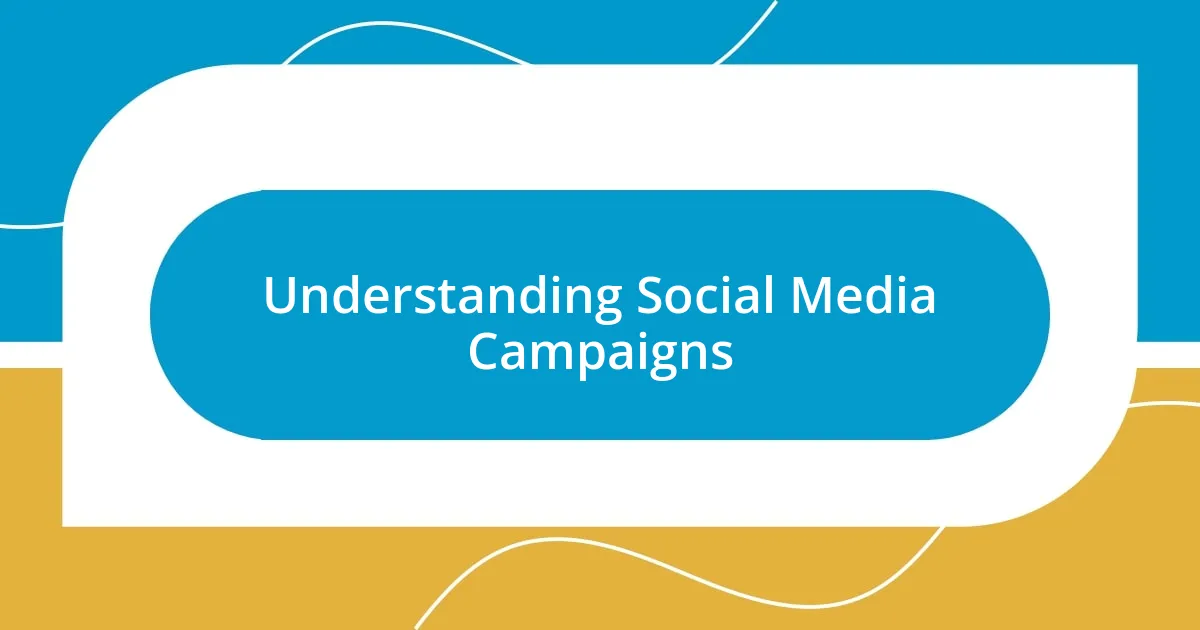
Understanding Social Media Campaigns
When I first dipped my toes into social media campaigns, I was stunned by their potential. It felt like I had unlocked a magic door to connect with audiences in ways I’d never imagined. Can you imagine crafting a message that resonates with thousands, even millions, instantaneously?
Understanding the heartbeat of a social media campaign means grasping its purpose and strategy. Each post isn’t just a piece of content; it’s a conversation starter, an invitation for your audience to engage. I remember launching a campaign that revolved around a community initiative. The responses were overwhelming, and it reminded me how powerful a shared vision can be.
What strikes me most about social media campaigns is adaptability. I often tweak my approach based on real-time feedback and analytics. Have you ever noticed how a small change can lead to unexpectedly great results? I once adjusted the timing of a post after analyzing audience activity, and the engagement skyrocketed! It’s this dynamic nature that makes social media an exciting playground for creativity and connection.
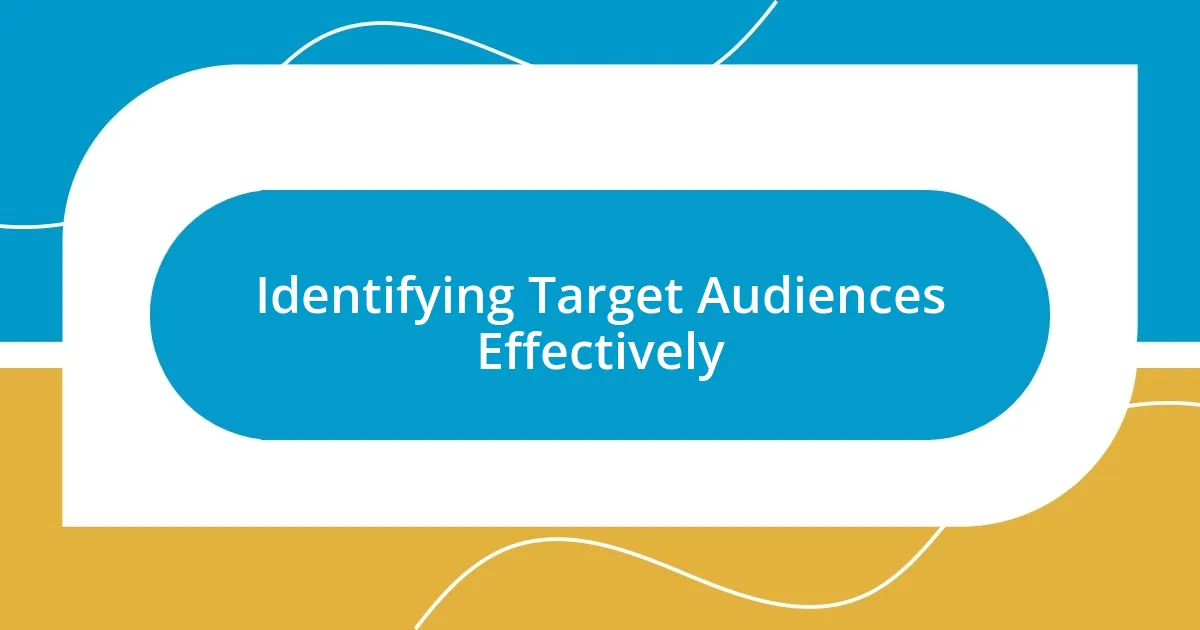
Identifying Target Audiences Effectively
Identifying the target audience effectively is crucial for the success of any social media campaign. It’s fascinating how a little research can reveal the nuances of who I’m trying to reach. I recall one campaign where, after some digging into demographics, I discovered that a significant portion of my audience was located in a specific region I hadn’t considered before. Adjusting my messaging to cater to their cultural sensitivities and interests transformed that campaign into one of my most successful ones.
To pinpoint your target audience accurately, here are steps that have worked for me:
- Analyze existing data: Look at your current audience insights on social media platforms.
- Conduct surveys: Don’t hesitate to ask your current followers what they love about your content.
- Create audience personas: Develop profiles for different segments to better tailor your messages.
- Monitor competitors: See who’s engaging with similar brands and what content resonates with them.
- Engage directly: Use polls or Q&A sessions in your stories to get immediate feedback.
I’ve found that this process not only clarifies my audience’s profile but also deepens the connection by showing that I genuinely care about their preferences.
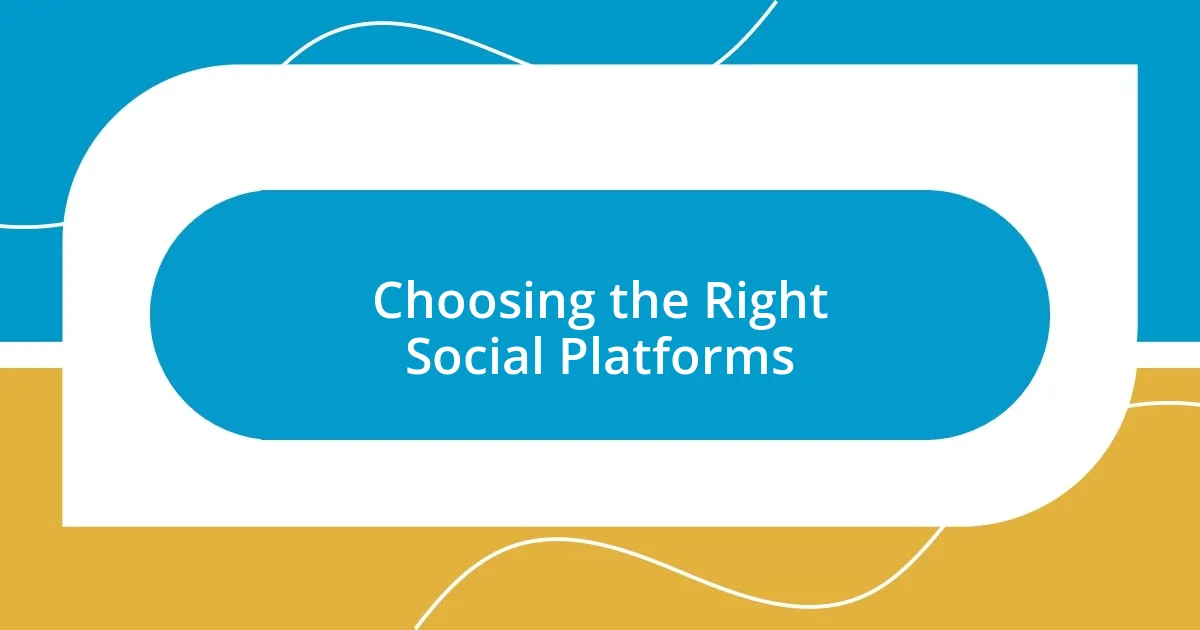
Choosing the Right Social Platforms
Choosing the right social platforms can significantly influence the success of my campaigns. I often find myself reflecting on where my audience spends their time online. For instance, when I launched a product aimed at a younger demographic, I prioritized platforms like Instagram and TikTok, where creativity thrives and visuals take center stage. On the flip side, when targeting professionals, platforms like LinkedIn became my best friend, allowing me to engage in thoughtful conversations and showcase my expertise.
As I navigated through various social media channels, I learned that it’s not just about being present everywhere; it’s about being present where it counts. I recall a time when I dedicated efforts to Facebook, filling my posts with engaging content, only to realize that my audience was largely elsewhere. The moment I shifted my focus to platforms like Twitter for real-time interaction, I saw a notable increase in engagement. It was a powerful reminder that understanding the nuances of each platform can lead to better connection and visibility for the message I want to share.
When deciding on the right platform, think about the style of your campaign and the nature of your content. Data analytics can help direct that decision. For example, if your campaign leans heavily on video content, YouTube and Instagram Reels might offer the best returns. Meanwhile, campaigns based on writing or professional development will thrive on LinkedIn. This tailored approach is what I believe creates more opportunities for meaningful interactions with my audience.
| Platform | Ideal Audience Type |
|---|---|
| Visual-driven, younger demographic | |
| Varied, family-centric users | |
| Professionals and industry leaders | |
| TikTok | Creative and younger audiences |
| Real-time engagement seekers |
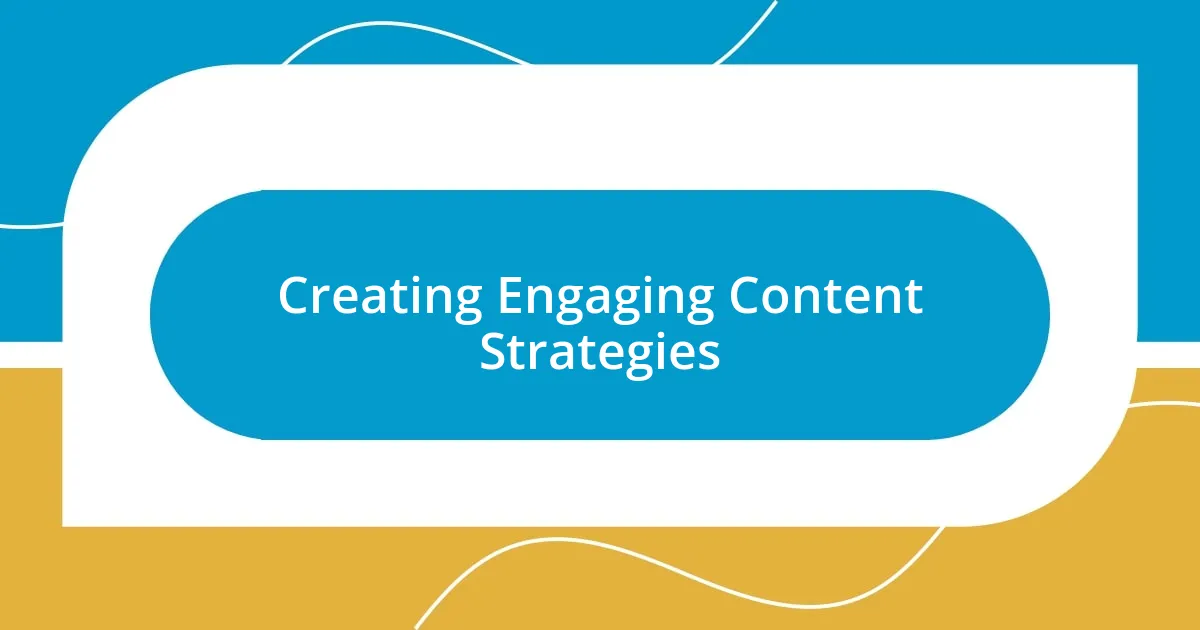
Creating Engaging Content Strategies
Creating engaging content strategies requires a deep understanding of what truly resonates with my audience. One of my favorite techniques is storytelling. I remember crafting a post that shared a personal failure and the lessons I learned from it. The engagement I received was overwhelming; people connected with the vulnerability in my narrative. Storytelling not only humanizes my brand but also encourages my audience to share their experiences, fostering a community feel that I cherish.
Visual elements are essential, too. Imagine scrolling through your feed—wouldn’t you stop for an eye-catching graphic or a compelling video? I once collaborated with a graphic designer to create a series of animated infographics highlighting the benefits of a product I was promoting. The result was stunning and led to a dramatic spike in shares. It made me realize that high-quality visuals can transform ordinary content into something magical that captures attention and drives engagement.
Lastly, I never underestimate the power of interactive content. Have you ever participated in a quiz or a poll on social media? I recently hosted a fun quiz related to a campaign theme and was amazed at how many people engaged and shared their results. It created buzz and encouraged conversations, not just about the campaign but also about related topics. This type of content not only keeps my audience engaged but also gives me invaluable insights into their preferences. So, what’s your next interactive idea going to be?

Measuring Campaign Performance Accurately
Measuring the performance of my campaigns accurately is essential for understanding what works and what doesn’t. One of my go-to methods is tracking engagement metrics like likes, shares, and comments. I distinctly remember launching a campaign where I was convinced that a particular video would go viral. However, after analyzing the data, I realized that a simple infographic outperformed it in terms of shares and engagement. It was a lesson in humility and taught me that sometimes, less flashy content can resonate more powerfully.
I’m always curious about how my audience interacts with my posts. Using tools like Google Analytics and social media insights helps me gauge the effectiveness of my campaigns. For example, when I tweaked the timing of my posts based on audience activity, I noticed a significant increase in reach and engagement. It made me appreciate that small adjustments can lead to impactful results. Have you tried adjusting your posting schedule? It’s fascinating how something so simple can make a difference.
Finally, setting specific goals for each campaign allows me to measure success quantitatively. Whether it’s increasing brand awareness or generating leads, I ensure my KPIs (key performance indicators) are clearly defined. I recall a campaign where my primary goal was to drive traffic to my website. After some analytic deep dives, I found that an unexpected platform was driving the most traffic. This insight helped me focus my future efforts effectively. What are your campaign goals, and how do you measure your success? Remember, knowing your numbers is just as important as creating the content itself.
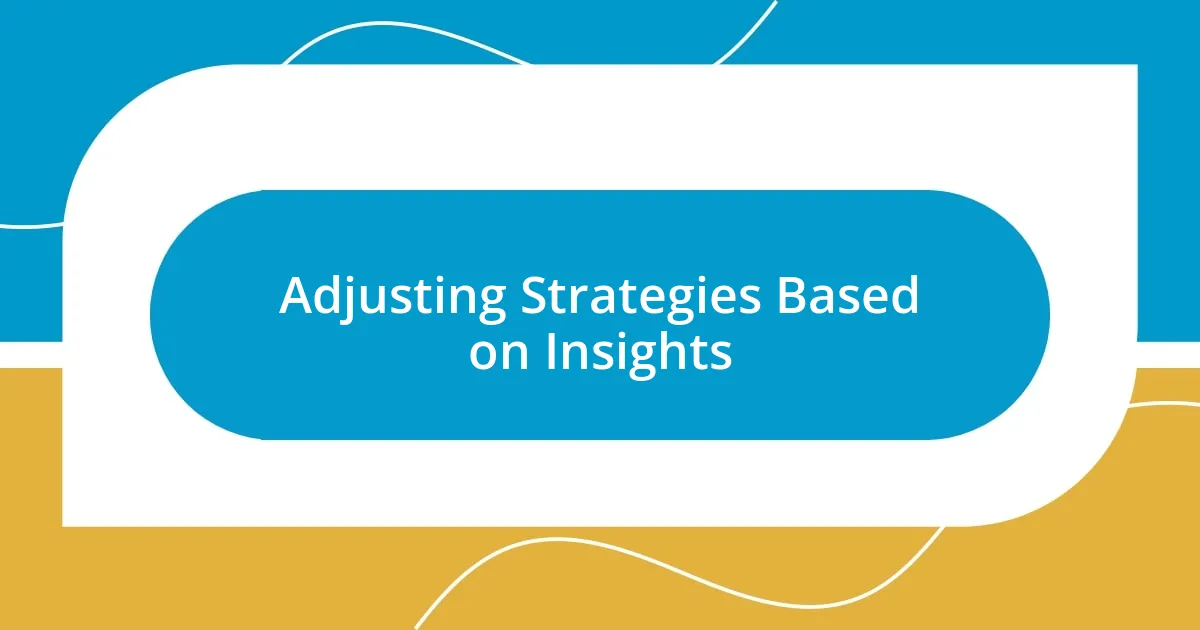
Adjusting Strategies Based on Insights
It’s fascinating how insights can shape my campaign strategies. For instance, when I noticed a dip in engagement on a specific type of post, I decided to dive deeper into the data. It turned out that my audience was craving more behind-the-scenes content. By shifting my focus, I not only revitalized my engagement rates but also built a more personal connection with my followers. Have you ever experienced an unexpected shift in what your audience wants?
Listening to audience feedback directly is another game changer. I once ran a campaign asking for suggestions on future content themes, and the responses astounded me. People weren’t just sharing preferences; they were offering unique angles I hadn’t considered. This input led to a series of posts that resonated deeply, and I felt empowered knowing I was creating content that genuinely reflected my community’s desires. It made me wonder—how often do you seek direct feedback from your audience?
Then there’s the importance of tracking trends over time. I remember a campaign where, after analyzing engagement patterns, I discovered a seasonal spike related to a specific topic. Embracing that insight, I created timely content that aligned perfectly with that peak interest. The results were fantastic! It reinforced my belief that adapting strategies based on concrete insights can transform not just individual campaigns, but the overall relationship I cultivate with my audience. What trends have you noticed in your campaigns that prompt you to pivot your strategy?
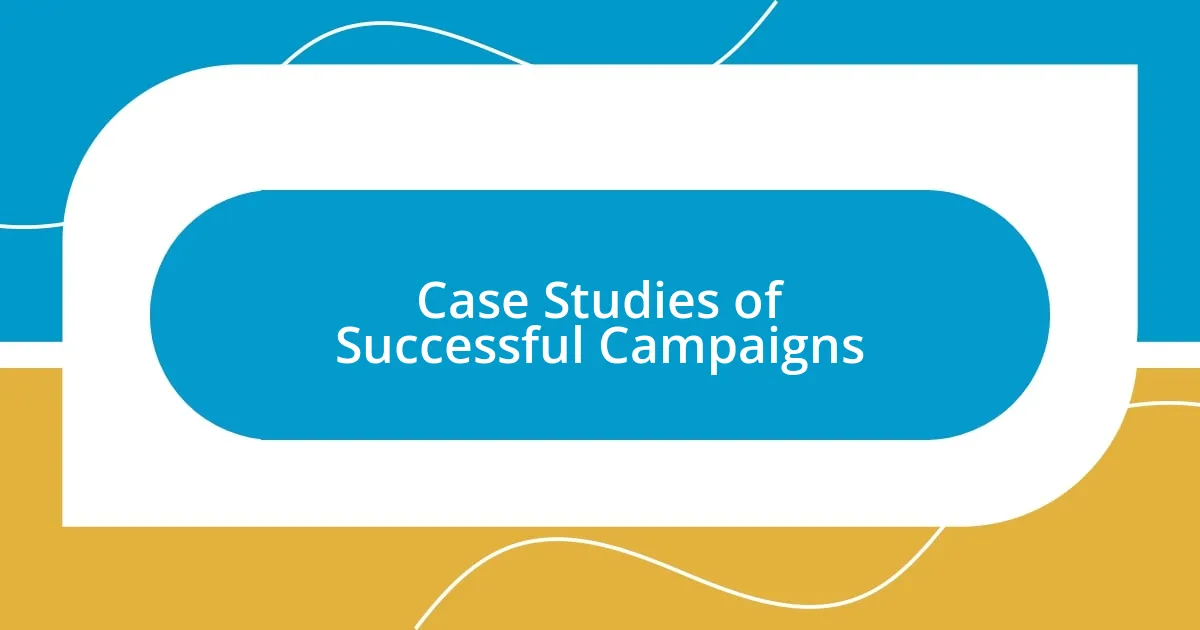
Case Studies of Successful Campaigns
I often reflect on the success of the #ShareYourStory campaign I launched last year. It encouraged my audience to share their personal experiences with my brand, and the response was overwhelming. Each shared story not only amplified community engagement but created an emotional connection that went beyond mere transactions. Have you ever felt that sense of kinship with your audience?
Another noteworthy case was when I integrated user-generated content into my campaign strategy. I asked my followers to post photos of themselves using my product with a dedicated hashtag. To my surprise, the engagement skyrocketed; seeing my product in their everyday lives made it feel more relatable and authentic. This experience taught me that sometimes, letting your audience take the spotlight can lead to unexpected outcomes. Have you considered how your customers can add value to your narrative?
One campaign that truly stood out was themed around mental health awareness. I partnered with several local influencers to spread their personal stories and struggles. The authenticity and vulnerability they shared resonated deeply, sparking conversations among my followers. This led to a powerful collective experience that not only raised awareness but also humanized my brand in a way I hadn’t anticipated. How do you go about aligning your campaigns with meaningful causes that matter to your audience?












